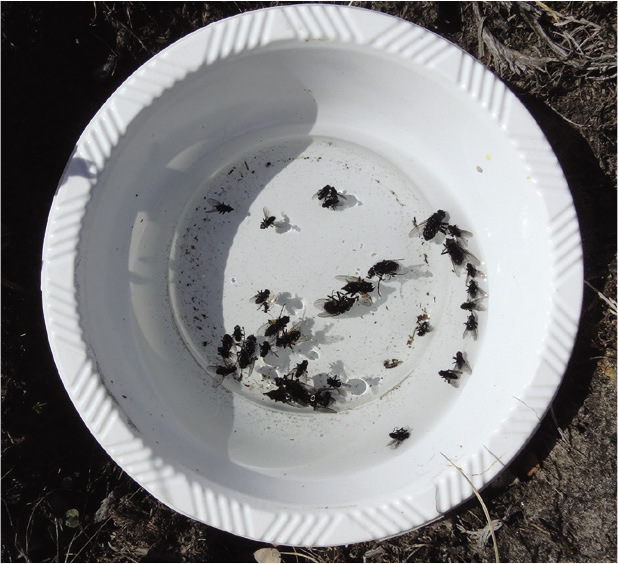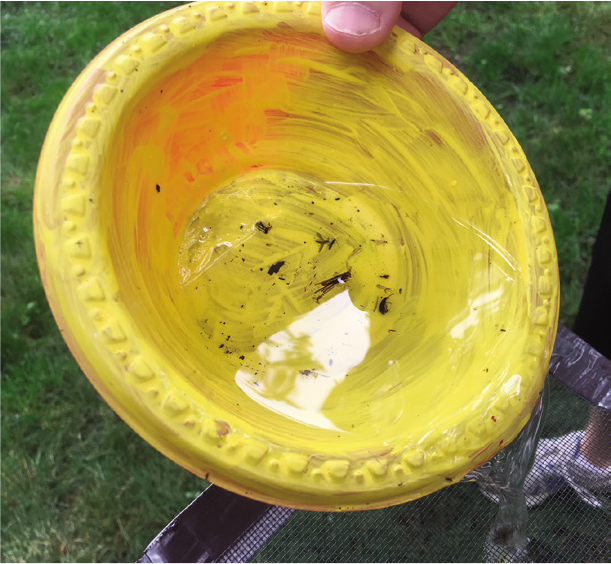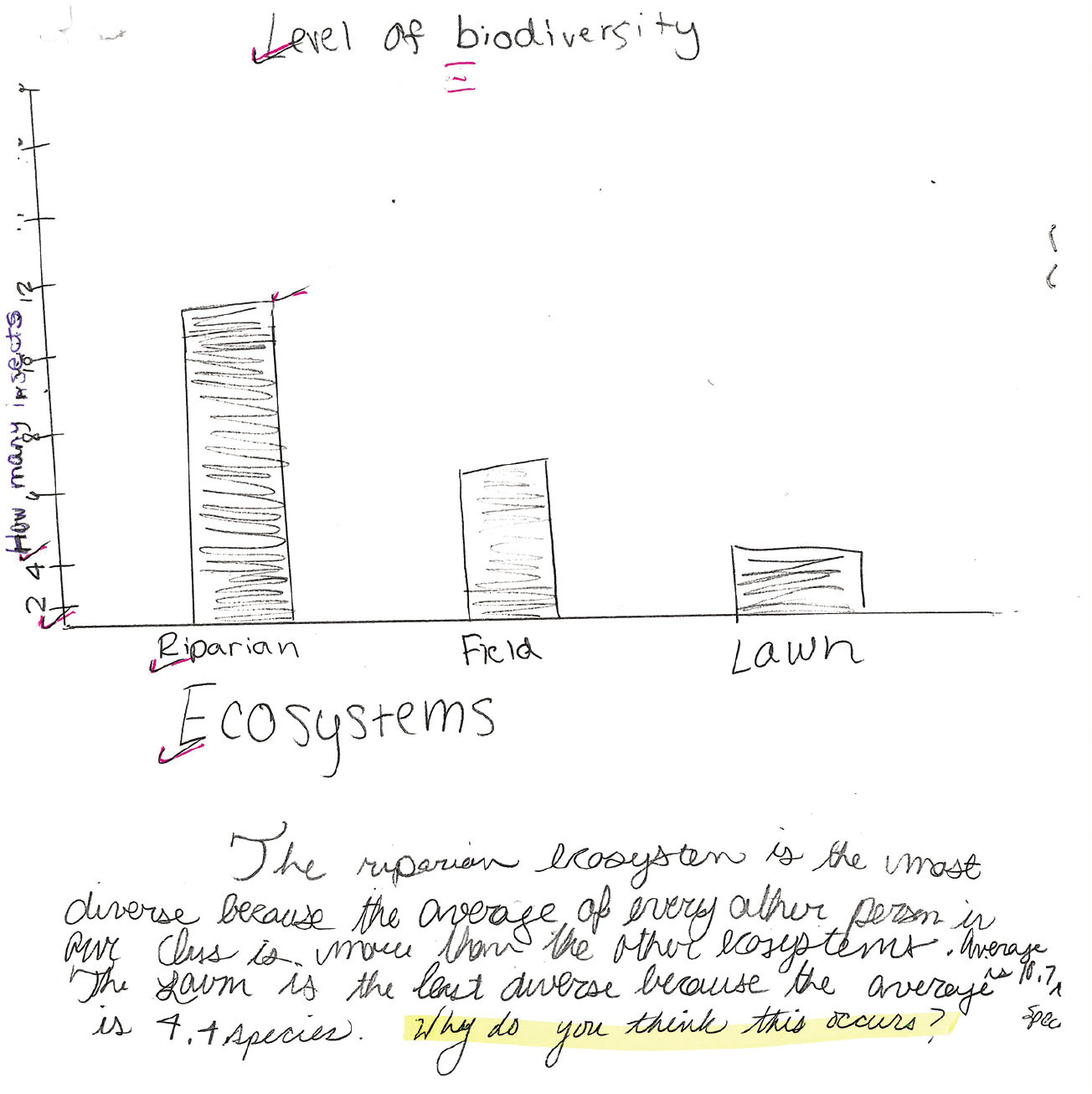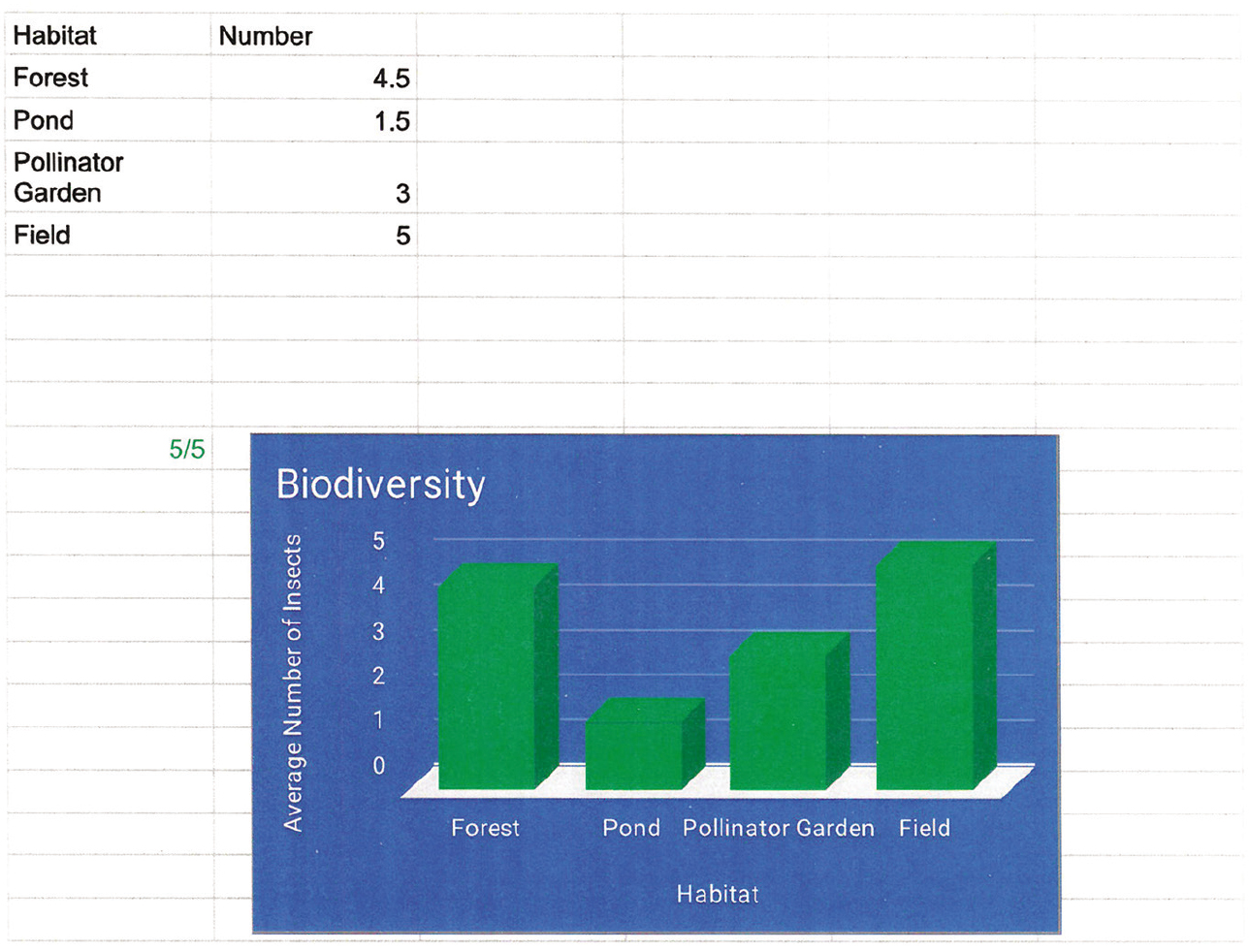Science on a Shoestring
Using Insect Biodiversity to Build Basic Skills
Using Insect Biodiversity to Build Basic Skills
By Anne Schoeffler
Insects can be used to explore biodiversity, collect and analyze data, and engage in inquiry. They can be collected with minimal expense and preparation and then used by students for skill-building in identification, graphing, and experimental design, depending on the instructor’s goals. The vast diversity of insect species is wondrous. Insects evolved from crustaceans more than 400 million years ago, long before the dinosaurs. They were the first organisms to develop the ability to fly. Today there are over 1,000,000 species of insects worldwide with every color and lifestyle imaginable.
The bowl trap methodology described in this article was used by the author while studying pollinator diversity in Greenland with PolarTREC (Climate Change and Pollinators in the Arctic 2016). It is a simple, effective means of introducing students to field work and environmental education, as well as generating authentic data. Groups of two to four students work well for these activities, which provide students opportunities to practice basic scientific skills using authentic, student-generated data. Moreover, the activities establish the concept of biodiversity, providing a foundation for biology and ecology lessons throughout the remainder of the academic year.
Collecting insects
A bowl of soapy water is a simple, yet effective trap for insects. Normally, small insects can safely land on the surface of water because the water molecules are attracted to one another by the force of cohesion. This force creates a skin on the water that small insects can walk upon. However, adding soap to a bowl of water disrupts the cohesive force, allowing insects to sink and become trapped (Figure 1).

Trapping procedure
For this activity, you will set out plastic, eight-ounce bowls of slightly soapy water as traps. You can place bowls 24 to 48 hours in advance of a class period, or students can take a few minutes of class time to set the bowls themselves. Check the weather forecast; bowls should be used when precipitation is not anticipated. Place the bowls in desired location(s), depending on the school campus. Possibilities include landscaped beds, lawns, wooded areas, meadow areas, ditch areas, and pond banks. Dumpster locations are not recommended based on experience; these bowls tend to be upended by animals that visit the dumpsters. (It is possible that some bowls will be lost due to wind, mowing, animal visits, or humans cleaning them up. It can be emphasized to students that this is one of the hazards of field work; it is important to try to anticipate problems of this type.)
- 1.
- A small depression can be prepared for each bowl; this is the method used weekly by the team with which the author worked in Greenland. Alternatively, a small, clean rock can be placed in each to prevent it from blowing away; this is the method used on our school campus.
- 2.
- Fill each bowl about 2/3 full with soapy water.
- 3.
- Wait 24–48 hours and then retrieve the bowls.
- 4.
- a. When retrieving the bowls, pour each one over a screen or sieve with very small holes. If it is windy, shield the insects collected on the screen. (Screens can be created by using sections of window screen about 20 cm [8 in.] square with duct tape around the borders. Fold the duct tape the length of each edge with half above and half below. See <a class="fig" href="#SS_03_F2">Figure 2</a>.)
- b. Students should wear goggles when pouring out the soapy water. If any insects are still alive, these may fly or walk away. Most stinging insects, especially bees and wasps, are strong enough to escape the bowls and thus are not encountered by students.
- 5.
- It is possible to save the insects for some time later in the academic year if that is desired. The teacher can store them in 70–90% ethanol in sealable containers or bags until they are needed.
- 6.
- Note that at the end of the activity insects can be disposed of in the environment. Any that were stored in ethanol may be placed in a trash receptacle.

Planning and carrying out investigations
Students can be given an opportunity to generate questions about collection locations, habitats, and even color. Either prior to the insect identification activity or afterward, once students understand the nature of the bowls, they can plan their own investigations and place their bowls in their preferred location (see below) after they have identified a question and written a hypothesis. Some possible questions include: What is the variety of habitats that we can identify on our own campus? Will we find more insects in a lawn or a landscaped bed? Will we find more insects in a riparian location (near a ditch, pond, or stream) or a drier location? Will we find greater diversity in one or another location? If our bowls are different colors, will insects prefer certain colors?
Analyzing and interpreting data
Students can use identification resources to document and compare diversity based on their findings by counting the number of insects or the number of insect families. Identifying the insects takes students some time, as they have not usually inspected insects closely before. Magnifying glasses and tweezers are useful tools. It is reasonable to expect that collecting the bowls and identifying one or more families will occupy a 40-minute class period. Using the collected insects, have students identify them using print resources or an online taxonomic key such as the one at KnowYourInsects.org. This site provides a dichotomous key, presenting a pair of questions on each page, letting students click each answer and taking them to more finely defined questions as they progress; ultimately, students will key an insect to a taxonomic family. In this way, students have the opportunity to sample the vast and diverse class, Insecta. An alternative method of identification is to use the iNaturalist app to identify the insects (see Resources). However, it bypasses the steps that scientists use in identifying organisms and doesn’t help students understand the nature of a dichotomous key. Through the identification process, students come to appreciate the diversity of life that surrounds them without their really having paid attention to it prior to their investigation. For most students their initial “Ewwww!” reaction transforms to one of curiosity pretty rapidly; of course, some students will continue to refuse to touch or engage with the insects, letting other members of their lab groups do the handling.
The data can be placed in a collated class spreadsheet to calculate averages for particular locations or bowl colors. Students can make inferences about their observations, and these form the basis of small-group or full-class discussions. Students may observe that there is more diversity in certain habitats than other locations. For example, there is often more diversity in a riparian location than in others. Ask students to speculate on why this might be. They may observe that there is more diversity in a naturalized area than in a lawn or landscaped area; ask students to speculate on the reasons.
Students may observe that certain insects appear to prefer certain colored bowls. (For example, in our experience, insects prefer white, yellow, and pink bowls to blue and green ones. In order to investigate color, bowls were painted with inexpensive acrylic paints.) Some research may indicate the preferences that the insects have for certain flowers based on color, shape, or scent. Students may also work individually or in groups to learn about the behavior and/or the evolution of one of their samples. Possible products include: a presentation about their insect’s habitat, a representative food web, an explanation of insect reproduction, a family tree for insect relationships, or a cladogram showing insect evolution.
Assessment ideas
There are numerous opportunities to assess students’ basic science skills, whether the instructor plans to grade these activities or use them as formative classroom experiences.
- 1.
- Graphing: Students at this level should be able to construct a proper graph with a title, axis labels, evenly spaced increments, and accurate representation of the data. Particularly at the beginning of the year, these data sets can be used for a graphing skills refresher, a baseline assessment, or a teaching opportunity.
- 2.
- Spreadsheet: Students at this level may be able to construct a data set on a spreadsheet and use that to construct a graph. They may or may not know how to title it and label the axes. Again, these data may provide an opportunity for teaching and/or baseline assessment, depending on students’ prior experience. Students at this level may or may not be able to use a spreadsheet to calculate sums and averages. While they probably do not have so much data that this would be difficult to do by hand, inputting this small data set is, nevertheless, a good opportunity to learn to use a spreadsheet or to practice with one.
- 3.
- Critical thinking: Through discussion, the class or the activity groups can discuss their findings and use them to make inferences as previously discussed.
- 4.
- Writing from evidence: Individually, students can each construct a conclusion paragraph in which they discuss their findings and support them with the quantitative evidence collected. This can be written in their science journal, or it can be written as a separate document. Using simple data of this sort can again give the instructor a baseline for formative assessment or can be graded for competence in evidence-based communication.
- 5.
- Extension: If students created a product to illustrate ecological niche or evolution of insects, then that product is also available for assessment. This may be a presentation, a diagram, or a slideshow.


Call for Departments
Science Scope features a number of departments that may be a good fit for your manuscript. The list of columns and their description is found below. For tips on preparing your manuscript, please review our Manuscript guidelines (www.nsta.org/middleschool/msguidelines-scope.aspx). Visit Manuscript Central (http://mc.manuscriptcentral.com/nsta) to register as an author and submit your article.
Integrating Technology
Submission deadline: Ongoing
Do you have a time-management strategy that relies on the use of technology or a favorite app to engage learners? Science Scope readers want to know how you use technology for assessment, student learning, or classroom management. Submit your idea in 1,200 words or less. Supporting materials such as screenshots, screencasts, and rubrics are welcome.
Science on a Shoestring
Submission deadline: Ongoing
Have you created inexpensive lab equipment or models to ensure that your students have opportunities to experience lab investigations and other activities critical to learning science? If so, consider sharing your ideas with Science Scope readers. All Science on a Shoestring submissions should be safe for use in the classroom and should include an introduction that explains the connection to the curriculum, as well as a list of materials and their approximate cost, a photograph of the equipment or model, assembly instructions, and tips for use in the classroom.
Teacher’s Toolkit
Submission deadline: Ongoing
In this column, you can share your how-to instructional strategies, practical advice, and classroom applicable results of action research with fellow middle level teachers. Tell us how you efficiently navigate today’s vast quantity of resources and websites to craft new lesson plans or to redesign/update older lessons to improve student achievement. What research-based practices do you use to guide your teaching? What are you doing to become familiar with the K–12 Framework for Science Education and prepare for the Next Generation Science Standards?
Classic Lessons 2.0
Submission deadline: Ongoing
Do you have a favorite classroom activity that you’ve updated to reflect current technology tools or the Next Generation Science Standards? Tell us what is special about the activity and describe the changes you have implemented that make the activity better than the original. Be sure to tell us how your lesson generates student excitement and promotes 3D learning.
Making in the Middle
Submission deadline: Ongoing
Do you have a science classroom activity that focuses on maker spaces, engineering, 3D printing, coding, robotics, or electronics? How about advice on how to fund a maker space, tie an engineering activity into your science curriculum, or maintain your new 3D printer? Science Scope is interested in publishing your ideas related to the maker space movement, specifically your easily replicable activities that use low-cost materials and have a strong connection to the science curriculum or to STEM. All manuscripts need to incorporate safety concerns as well as a list of materials and their cost. Supporting documentation such as rubrics, photographs, and “how-to” videos are encouraged.
Practical Research
Submission deadline: Ongoing
Do you have relevant research to share with middle school science teachers? Perhaps you are you a teacher who has conducted action research in your classroom? Science Scope readers are looking for ideas that demonstrate how they can apply research results to their classroom. Consider submitting a brief, practical overview of your research findings as they relate to pedagogy, technology integration, differentiation, special needs populations, or assessment in the middle school classroom. Submit your manuscript in 1000 words or less.


